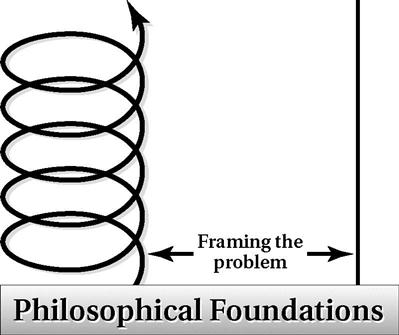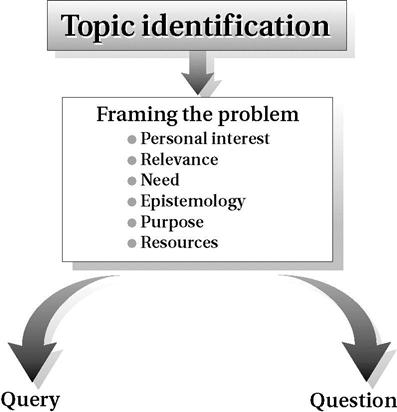Framing the Problem
Key terms
Problem statement
Purpose statement
Research topic
Where do you begin now that you are ready to participate in the research process? An important initial challenge in the conduct of research is the selection of a topic and, within that area, a specific problem that is meaningful to study, appropriate for scientific inquiry, and purposeful. By “meaningful”

we suggest that the identified research problem should lead to an inquiry that allows the development of new knowledge or verification of existing knowledge that is useful to the individual, his or her profession or social group, or both. By “appropriate” we mean that the selection of a problem can be submitted to a systematic research process and that the research will yield knowledge to help solve the identified problem. Not all problems relevant to health and human service providers can be addressed through systematic inquiry. By “purposeful,” we suggest that health and human service research be designed with purposes that serve investigators, consumers, professionals, funders, policy makers, and others concerned with the delivery of health and human services.
Most beginning researchers are able to identify a topic of interest to them. However, many find that identifying a specific research problem within a topic of interest is a more difficult task. This difficulty is caused in part by the novice investigator’s unfamiliarity with problem formulation and its relationship to the research process. It is important to recognize that the way in which a research problem is framed influences and shapes all subsequent thinking and action processes. More specifically, as depicted in Figure 4-1, the way the research problem is framed will lead to the development of a specific research question in the experimental-type tradition of research, or to a line of query in the naturalistic tradition, or to a question and query that integrate both research traditions. Thus, problem identification is not simply a matter of isolating a specific problem statement; one must also have a clear understanding of the relationships among topic, problem formulation, research question/query, and action processes to frame a meaningful, appropriate, and purposeful problem statement.

Problem formulation is also influenced by the personal characteristics of the researcher, including personal interest, perceived need, and preferred epistemology (Box 4-1).
This chapter examines the thinking processes involved in identifying a topic, framing a research problem, and linking design selection to the purpose of the study.
Identifying a topic
The first consideration in beginning a research project is to identify a topic from which to pursue a specific investigation. A research topic is a broad issue or area that is important to a health and human service professional. One topic may yield many different problems and strategies for investigation.
It is usually easy to identify a topic that is of personal interest or one that is relevant to and important for professional practice.
Where do topics and specific problem areas come from? There are five basic sources helpful to professionals in selecting a topic and researchable problem (Box 4-2).
Professional Experience
The professional arena is perhaps the most immediate and important source from which research problems evolve. The ideas, unanswered questions, or “professional challenges” (similar to those posed in Chapter 1) that routinely arise often yield significant areas of inquiry. A reflective practitioner can pose many queries in the course of service delivery that may warrant the research process. Many of the themes or persistent issues that emerge in case review, supervision, or faculty, student, and staff conferences may provide investigators with researchable topics and specific questions/queries. Themes that cut across diverse individuals, such as family involvement or consumer perceptions of their experiences in health and human services, provide topics that may ultimately stimulate the framing of specific research problems.
Societal Trends
Social concerns and trends reflected in the policies, legislation, and funding priorities of federal, state, and local agencies, foundations, and corporations provide another critical area from which potential inquiries for health and human service investigation emerge. For example, the government reports Healthy People 2010 and 2020, U.S. Public Health Service documents, establish health-related objectives and priorities for the United States. Similarly, the reports on health care and practice generated by the Institute of Medicine (IOM) also identify priority research areas. For example, its 2001 publication, “Crossing the Quality Chasm: A New Health System for the 21st Century,” outlines the fundamental changes needed in the U.S. health care system, which are still relevant today. Similarly, its recent book, Retooling for America, provides important data about current health care and raises the many difficult problem areas that must be addressed through research, education, and change in health policy. You may also want to look at the publications of the World Health Organization (WHO) or Rehabilitation International to identify international priorities. These types of documents provide an important source for identifying research problems and specific questions and queries with high public health importance.
Another social arena from which research problems emerge is the set of specific requests for research generated by federal, state, and local governments. Government agencies have numerous established funding streams that provide monetary support to researchers who identify meaningful and appropriate research problems within topic areas relevant to the delivery of health and human services.
Stay updated, free articles. Join our Telegram channel

Full access? Get Clinical Tree








 Examples of topics may include but are not exclusive of posthospital experience, health disparities, health promotion in diverse communities, pain control, community independence, adaptation to functional limitations, drug abuse, hospital management practices, gender differences related to retirement, symptom presentation, health experiences, psychosocial aspects of illness, disablement, or wellness, creativity as a source of coping and wellness, or impact of specific interventions.
Examples of topics may include but are not exclusive of posthospital experience, health disparities, health promotion in diverse communities, pain control, community independence, adaptation to functional limitations, drug abuse, hospital management practices, gender differences related to retirement, symptom presentation, health experiences, psychosocial aspects of illness, disablement, or wellness, creativity as a source of coping and wellness, or impact of specific interventions.






 A rehabilitation professional in an inpatient rehabilitation hospital posed to us an observation that she and her staff found intriguing. They observed that many adaptive devices issued to patients for self-care were often left behind by patients in their rooms at time of discharge. Although she believed patients needed these devices to function independently in their homes, she wondered why patients did not think similarly. When the devices were taken home, she also wondered whether they were used and, if so, whether they enhanced patients’ functioning in their environment. Discussions with practitioners in other hospital sites revealed similar observations and concerns. A review of the literature showed no studies on patient appraisals of adaptive equipment and use post-hospitalization. Here, then, is an identified clinical problem worthy of systematic inquiry. Think about the specific researchable questions that can be pursued to examine device use and abandonment systematically.
A rehabilitation professional in an inpatient rehabilitation hospital posed to us an observation that she and her staff found intriguing. They observed that many adaptive devices issued to patients for self-care were often left behind by patients in their rooms at time of discharge. Although she believed patients needed these devices to function independently in their homes, she wondered why patients did not think similarly. When the devices were taken home, she also wondered whether they were used and, if so, whether they enhanced patients’ functioning in their environment. Discussions with practitioners in other hospital sites revealed similar observations and concerns. A review of the literature showed no studies on patient appraisals of adaptive equipment and use post-hospitalization. Here, then, is an identified clinical problem worthy of systematic inquiry. Think about the specific researchable questions that can be pursued to examine device use and abandonment systematically. In the arena of health promotion and disease prevention, the Centers for Disease Control and Prevention (CDC) issued a call for research that focuses on the identification of risk factors related to secondary disability and its prevention. The Department of Health and Human Services (DHHS) has issued requests for research proposals to study the effects of welfare reform on the health of children living in poverty.
In the arena of health promotion and disease prevention, the Centers for Disease Control and Prevention (CDC) issued a call for research that focuses on the identification of risk factors related to secondary disability and its prevention. The Department of Health and Human Services (DHHS) has issued requests for research proposals to study the effects of welfare reform on the health of children living in poverty.